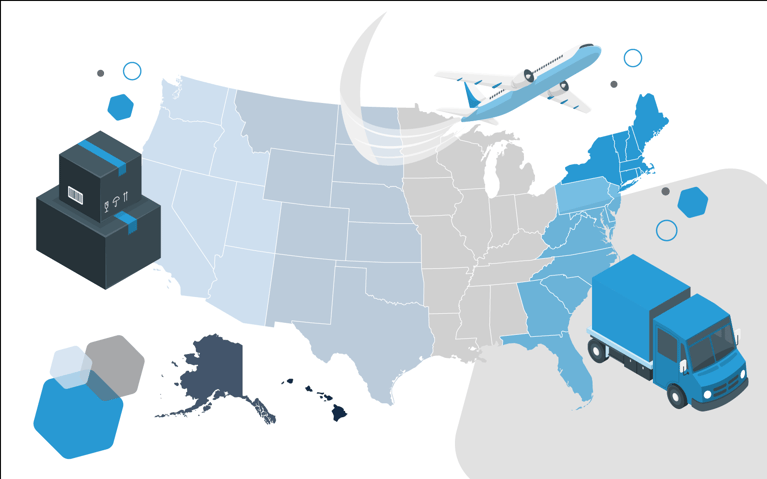Originally posted August 22, 2023, updated May 29, 2024 by A. Wolfe.
In the swiftly advancing ecommerce industry, businesses constantly seek ways to optimize their operations. The end-to-end customer experience has become increasingly important, particularly during the post-purchase. One crucial aspect of online retail that requires continuous innovation is ecommerce fulfillment. This comprehensive process involves managing inventory levels, processing orders, shipping orders and handling returns. As ecommerce businesses grow and expand, the complexity of their fulfillment processes also grows. This blog post delves into the new rules of ecommerce fulfillment and provides key insights to help you transform your logistics performance while addressing your changing needs.
The intricacies of ecommerce fulfillment
Ecommerce fulfillment is more than just packing and shipping orders. It's a complex process that involves a multitude of steps, from managing inventory levels across various sales channels to ensuring that orders are picked and packed efficiently. As ecommerce businesses grow, so too does the complexity of their fulfillment processes.
Ecommerce fulfillment processes include several critical operations that ensure that products reach customers efficiently and accurately. The process begins with inventory management, where products are stored and tracked in a warehouse. When an order is placed, the order processing stage initiates, involving the picking of items from storage, packing them securely and preparing them for shipment.
Next, the shipping process takes place: Selecting a shipping carrier, printing labels and dispatching packages. It's essential to use reliable carriers and choose appropriate shipping options to meet consumer delivery expectations. After shipping, order tracking allows both the business and customers to monitor the package's journey until it reaches its destination.
Once delivered, the returns management process handles any returns or exchanges and updates and changes in inventory levels. Throughout these ecommerce fulfillment stages, robust systems and technologies, like warehouse management systems (WMS) and order management systems (OMS), are essential for optimizing efficiency, reducing errors and maintaining high customer satisfaction. Effective communication and coordination among different teams are also vital to streamline the entire fulfillment process.
The new rules of ecommerce fulfillment
 Inbound logistics: In ecommerce fulfillment, having sufficient receiving dock capacity and warehouse space is just the beginning. Inefficiencies in fulfillment supply chains often start with this step, also known as first-mile delivery.
Inbound logistics: In ecommerce fulfillment, having sufficient receiving dock capacity and warehouse space is just the beginning. Inefficiencies in fulfillment supply chains often start with this step, also known as first-mile delivery.
For example, receiving incorrect inventory can disrupt your entire supply chain, particularly if upcoming orders rely on the next inventory shipment. Optimizing inbound logistics is vital for enhancing supply chain efficiency and reducing costs. This begins by collaborating closely with suppliers to improve communication and sharing demand forecasts. It also means Implementing robust inventory practices and using automated systems to track and reorder stock efficiently.
Ecommerce businesses must choose reliable transportation partners, consolidate shipments and use route optimization software to cut transit times and costs. Invest in a robust Transportation Management System (TMS) and leverage electronic data interchange (EDI) for seamless information exchange. Consider cross-docking to minimize handling and storage and allow suppliers to manage inventory through Vendor-Managed Inventory (VMI) programs. Businesses must integrate with first-mile systems and data for prompt and accurate receiving. Businesses often benefit from partnering with technology-enabled 3PLs, which help manage logistics from warehousing and fulfillment to shipping, ensuring seamless operations from first to last mile.
 Inventory management: Effective inventory management is crucial for today’s ecommerce fulfillment operations. A well-configured and labeled rack and bin infrastructure is foundational, but modern businesses must also leverage advanced software and hardware systems for scanning and sorting. These tools facilitate accurate labeling and efficient inventory storage, ensuring that items are easily accessible and accounted for.
Inventory management: Effective inventory management is crucial for today’s ecommerce fulfillment operations. A well-configured and labeled rack and bin infrastructure is foundational, but modern businesses must also leverage advanced software and hardware systems for scanning and sorting. These tools facilitate accurate labeling and efficient inventory storage, ensuring that items are easily accessible and accounted for.
In modern ecommerce, basic data capabilities are insufficient. Fulfillment operations require comprehensive order and inventory management tools to provide complete operational visibility. Any disconnect between customer-facing platforms and backend systems can lead to significant issues such as inventory inaccuracies, mislabeling and poor forecasting. These disruptions can result in stock imbalances and delayed shipments, affecting the customer experience.
To mitigate these risks, brands should invest in robust business intelligence tools, real-time tracking systems, warehouse analytics and AI-driven forecasting. These technologies enhance inventory accuracy, streamline operations and improve demand forecasting. Real-time tracking ensures that inventory levels are always up-to-date, reducing the likelihood of stockouts or overstock situations. Warehouse analytics provide insights into operational efficiency, helping to identify areas for improvement. AI-driven forecasting allows businesses to predict demand more accurately, ensuring they can meet customer needs without overcommitting resources.
By optimizing warehouse layout and storage for product type and amount and integrating these advanced tools and systems into their operations, businesses can achieve a higher level of inventory management, leading to increased efficiency, reduced costs and improved customer satisfaction.

Order management: Order management plays an enormous role in ecommerce fulfillment, as it facilitates order transmission and routing accurately across systems. Beyond this basic requirement, businesses must optimize order routing and orchestration across channels and facilities using real-time inventory, location and operational data. This approach enhances efficiency and accuracy, ensuring that customers receive their orders promptly and correctly.
As businesses scale, the complexity of order management and routing increases due to the influx of orders from multiple channels. Transitioning a facility to handle omnichannel operations is particularly challenging when relying on single-channel tools and vendors. Existing resources may not suffice for modern multichannel demands, making it essential to reassess and update your team, technology stack and 3PL (third-party logistics) partners to meet these needs effectively.
Optimizing order management involves integrating advanced order management systems (OMS) that can handle multichannel inputs and coordinate fulfillment strategies dynamically. These systems help streamline operations by providing a unified view of orders and inventory, enabling better decision-making and faster responses to market changes. Moreover, investing in technologies that support real-time data analytics and automation can significantly improve order accuracy and fulfillment speed.
Picking, packing and shipping: Software-aided picking that ensures item and order level accuracy is crucial. But businesses can further increase picking speed and efficiency and limit human movement through software and hardware automation.
A proper balance in automation is crucial. Under-investing will cause your fulfillment operation to lag behind the competition, while over-automating might overlook essential human activities, affecting efficiency and accuracy. It's vital to find a 3PL that understands automation technologies and can integrate them effectively into current practices.


Building deep last mile carrier partnerships: Businesses should forge tight partnerships and data integrations with last mile partners to keep customers informed, manage expectations and respond to issues more proactively.
Currently, the data an ecommerce merchant has access to is often the same as the customer, so sellers are often unable to answer any order-related questions once it has been received by the carrier. The resulting customer frustration can be avoided by having OMS and WMS platforms more natively integrated with carrier systems. That way, fulfillment operations and carriers are sharing upstream and downstream data, allowing customers to receive updates down to the last mile.
Understanding the nuances of reverse logistics: Streamlining reverse logistics, also known as the process of managing returns from customers, presents its own unique challenges. Unlike straightforward shipments, returns start with customers, who usually don't have the means to efficiently reintegrate products into the shipping system. This asymmetry between shipping out and shipping back makes the returns process disjointed. Including return labels with original orders provides no guarantee of usage, and even if customers print labels from websites, the return's timing remains uncertain. Handoffs at carrier locations, such as FedEx or UPS, can also be unclear unless integrated with the fulfillment center.
Returns Management Systems can improve this clarity, but the future of fulfillment demands even more sophisticated integration. Operational challenges persist, as not all facilities are equipped for return processing. For ecommerce businesses, establishing robust return integration, evaluating return capabilities and clear return guidelines are paramount.
Cart.com for ecommerce fulfillment
Mastering the new rules of ecommerce fulfillment can help your business meet customer expectations for fast and efficient service and reduced shipping. Whether you're handling fulfillment in-house or outsourcing to a third-party logistics (3PL) provider, understanding and optimizing your fulfillment process is key to your ecommerce success. Contact our team to see how Cart.com can optimize your ecommerce fulfillment operations. For more detailed insights, you can also download our ebook "The New Rules of Ecommerce Fulfillment" here.
Subscribe to our emails for the latest industry insights!
By entering your email, you agree to receive marketing emails from Cart.com








